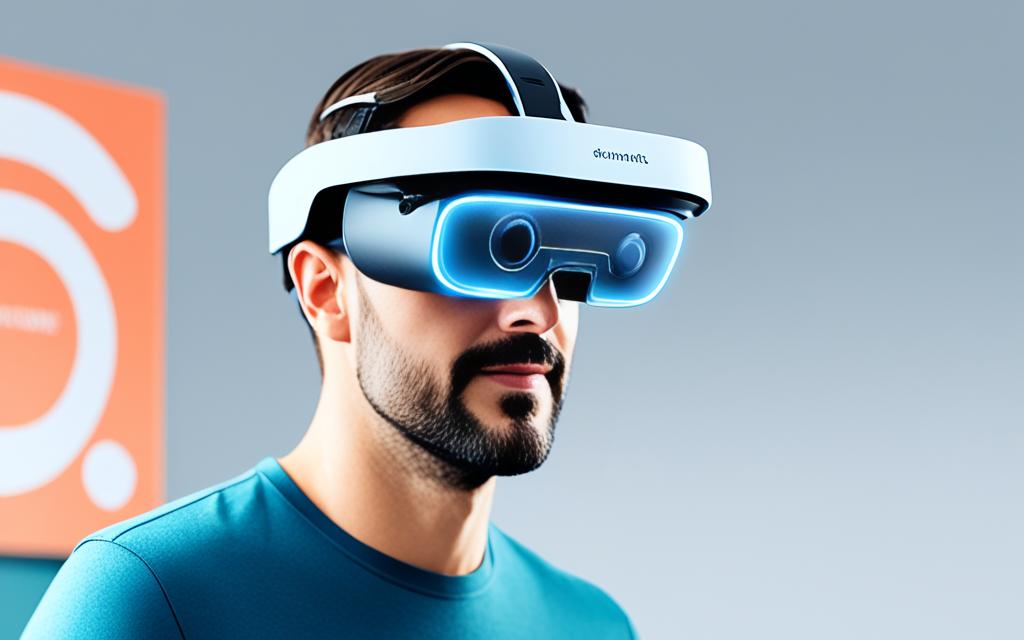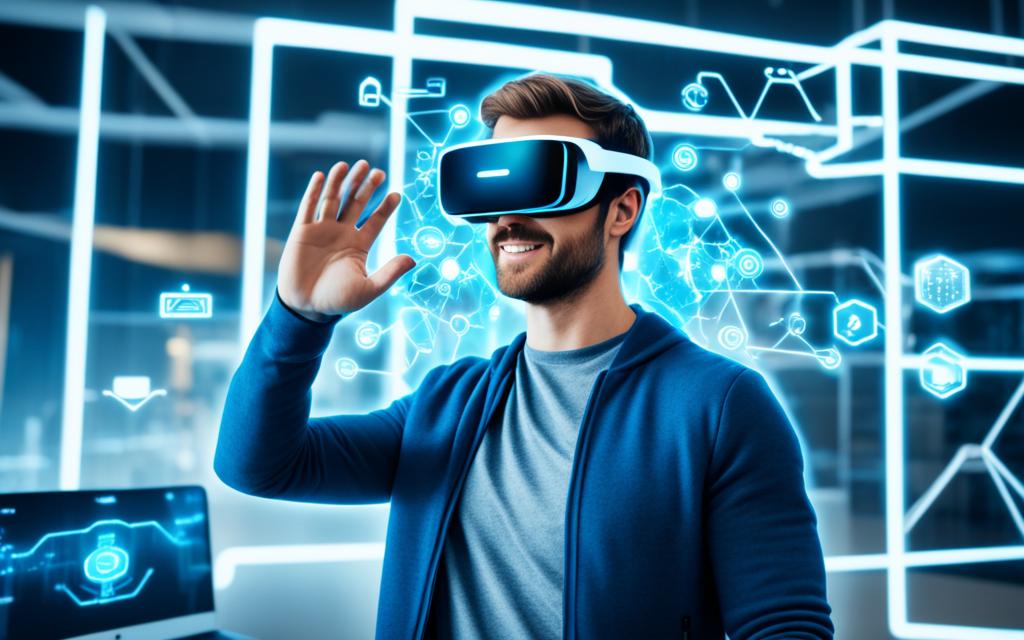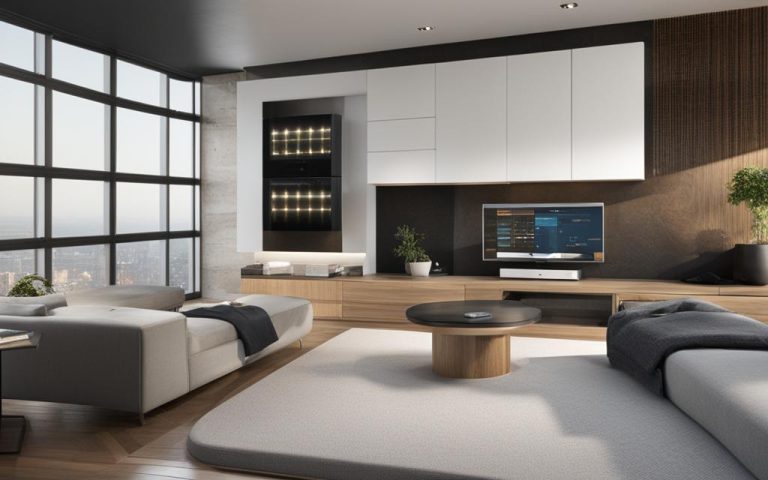Augmented reality (AR) has emerged as a groundbreaking technology with the potential to revolutionize numerous industries. From entertainment to education, AR has proven its worth in enhancing user experiences. However, its impact on social interactions remains relatively uncharted territory.
Recent studies have focused on exploring the social psychological effects of AR, shedding light on how it can significantly influence task performance, nonverbal behavior, and social connectedness. By integrating AR into personal area networks (PANs), we can unlock a new realm of possibilities for enhancing interactions and transforming the way we engage with our personal devices.
As the boundaries between the physical and virtual worlds blur with AR, we have the opportunity to create more immersive and engaging user experiences. By seamlessly integrating digital content with the real world, AR can bridge the gap between technology and human interaction.
In the following sections, we will explore the role of AR in user interface (UI) design, the challenges associated with integrating AR into UI, best practices for designing AR user interfaces, the technical considerations involved, and real-world examples of AR prototypes for controlling network devices. Through this exploration, we aim to provide insights and strategies that will empower designers and developers to leverage AR effectively in PANs.
The Role of AR in UI Design
Augmented reality (AR) is a powerful tool that is transforming the field of user interface (UI) design. With its ability to merge digital content seamlessly with the real world, AR offers a range of benefits that enhance interaction, increase contextual relevance, and unlock innovative design possibilities. In this section, we’ll explore the role of AR in UI design and how it is reshaping the way we interact with digital products and services.
One of the key advantages of AR in UI design is its ability to create engaging and personalized user experiences. By blending virtual and real-world elements, AR interfaces provide users with a unique and immersive interaction environment. This enhanced engagement not only captures users’ attention but also enables designers to deliver content that is tailored to individual needs and preferences.
AR also brings contextual relevance to the forefront of UI design. By overlaying digital information onto the physical world, AR interfaces provide users with real-time and location-based data. This contextual information enables users to make more informed decisions and enhances the usability of digital products and services.
Furthermore, AR opens up new design possibilities by introducing dynamic and interactive elements into UIs. With AR, designers can create interfaces that respond to user actions and gestures, allowing for more intuitive and natural interactions. This dynamic nature of AR interfaces enhances usability, making it easier for users to navigate through digital content and perform tasks.
Improved accessibility is another significant benefit of AR in UI design. By integrating digital content directly into the real world, AR eliminates the need for users to rely solely on traditional screens or input devices. This makes digital information and functionalities more accessible to individuals with diverse abilities, enhancing inclusivity in UI design.
AR is transforming the way we design user interfaces, creating dynamic and interactive experiences that improve usability, engagement, and contextual relevance.
In conclusion, augmented reality plays a critical role in UI design by offering enhanced interaction, contextual relevance, innovative design possibilities, and improved accessibility. AR interfaces enable designers to create engaging and personalized user experiences, leveraging the power of blending virtual and real-world elements. With AR, UI design is evolving to create dynamic and interactive interfaces that enhance usability and appeal. By embracing AR, designers can unlock new possibilities and create interfaces that truly transform the way users interact with digital products and services.
Overcoming AR Integration Challenges in UI
Integrating augmented reality (AR) into user interfaces (UI) presents unique challenges. Successful implementation of AR requires addressing various aspects, including hardware compatibility, user experience optimization, content creation, performance and battery optimization, privacy and security considerations, and legal and ethical concerns. Overcoming these challenges is crucial for developing AR applications that deliver seamless and engaging user experiences.
Hardware Compatibility
One of the primary challenges in AR integration is ensuring compatibility between hardware devices and software applications. AR relies on sophisticated sensors and cameras, requiring devices with sufficient processing power, memory, and graphical capabilities. Compatibility issues can limit the availability and accessibility of AR experiences, making it essential to design interfaces that work seamlessly across a wide range of devices.
User Experience Optimization
Creating a compelling user experience is crucial in AR UI design. AR introduces a new dimension to interactions, blending digital content with the real world. Designers must ensure that AR interfaces are intuitive, intuitive, easy to learn, and provide clear feedback to users. The challenge lies in striking a balance between incorporating AR elements and maintaining simplicity and usability.
Content Creation
Developing relevant and engaging AR content is another challenge in UI design. AR content must align with the user’s context and provide value through interactive and informative experiences. Designers must consider the limitations and possibilities of the hardware devices to deliver content that seamlessly integrates with the user’s environment.
Performance and Battery Optimization
AR applications often require intensive computational processes, which can impact device performance and battery life. Loading and rendering AR content in real-time places a significant strain on the device’s resources. Optimizing performance and battery usage is critical to ensure a smooth and uninterrupted AR experience.
Privacy and Security
AR raises privacy and security concerns due to its ability to capture and process real-time data. Designers must implement measures to protect user privacy, such as obtaining appropriate consent and anonymizing data collection. Ensuring the security of AR applications and preventing unauthorized access is also paramount.
Legal and Ethical Considerations
The integration of AR into UI design brings forth various legal and ethical considerations. These include intellectual property rights, data ownership, privacy regulations, and ethical use of AR technologies. Designers must navigate these complexities and ensure compliance with relevant laws and ethical guidelines to avoid legal repercussions and ethical dilemmas.
Overcoming AR integration challenges requires a comprehensive understanding of technical considerations, user needs, and best practices in UI design. By addressing hardware compatibility, optimizing user experience, creating relevant content, addressing performance and battery issues, ensuring privacy and security, and navigating legal and ethical concerns, designers can develop successful AR applications that deliver immersive and meaningful user experiences.
| Challenges | Solutions |
|---|---|
| Hardware Compatibility | Design interfaces that work seamlessly across a wide range of devices. |
| User Experience Optimization | Create intuitive and user-friendly interfaces that provide clear feedback. |
| Content Creation | Develop relevant and engaging AR content that seamlessly integrates with the user’s environment. |
| Performance and Battery Optimization | Optimize performance and battery usage to ensure a smooth AR experience. |
| Privacy and Security | Implement measures to protect user privacy and ensure the security of AR applications. |
| Legal and Ethical Considerations | Navigate legal complexities and comply with ethical guidelines to avoid legal and ethical issues. |
Best Practices for AR in UI Design
Designing effective AR user interfaces requires following best practices that prioritize user experience, create a sense of presence, prioritize interactivity, ensure consistency and continuity, enhance accessibility, and include thorough testing and iteration. By understanding user needs, incorporating immersive elements, designing for interaction, maintaining consistency, and considering accessibility, developers can create AR applications that are user-friendly, engaging, and intuitive.
- Prioritize user experience: Design AR interfaces with the user in mind. Consider the user’s goals, preferences, and limitations to create a seamless and enjoyable experience.
- Create a sense of presence: Make the virtual content feel integrated into the real world by using realistic graphics, accurate positioning, and natural interactions.
- Prioritize interactivity: Enable users to interact with the AR interface through gestures, voice commands, or other intuitive means. This enhances engagement and immersion.
- Ensure consistency and continuity: Maintain a consistent design language and user interface elements throughout the AR application. This helps users navigate and interact with the virtual content seamlessly.
- Enhance accessibility: Consider the accessibility needs of all users, including those with disabilities. Provide options for customization and alternative input methods.
- Thorough testing and iteration: Test the AR application extensively to identify and fix any usability issues or bugs. Iterate on the design based on user feedback to continuously improve the user experience.
AR user interfaces should be designed with the goal of providing a seamless and intuitive experience for users. By following these best practices, developers can create AR applications that enhance usability, engagement, and user satisfaction.
Creating effective AR user interfaces involves a combination of technical expertise and a deep understanding of user needs. By implementing these best practices, developers can ensure that their AR applications deliver a compelling and immersive user experience.

Stay tuned for the next section, where we will explore the technical considerations involved in integrating AR into user interfaces and personal area networks.
Technical Considerations in AR Integration
Integrating augmented reality (AR) into user interfaces requires careful attention to various technical considerations. These considerations include:
- Hardware Compatibility: AR applications must be compatible with a range of devices, from smartphones to smart glasses. This ensures that users can enjoy AR experiences regardless of the device they are using.
- Software Processing: Efficient processing is crucial for seamless AR integration. Developers need to optimize software algorithms to deliver real-time AR experiences without impacting device performance.
- Projection and Reflection Techniques: AR content needs to be projected and reflected onto the user’s environment convincingly. This requires precise calibration and alignment to ensure a seamless integration of virtual and real-world elements.
- Software Development: Building AR applications involves interpreting and rendering augmented experiences. Developers must create robust software infrastructure that handles tracking, mapping, rendering, and interaction for a smooth user experience.
By considering these technical aspects, developers can ensure that AR applications adapt to different hardware, offer efficient processing, effectively project digital content, and provide a seamless integration of augmented experiences.
| Technical Consideration | Description |
|---|---|
| Hardware Compatibility | AR applications should be compatible with various devices to cater to a wide user base. |
| Software Processing | Efficient processing of AR content is crucial to maintain real-time experiences without compromising device performance. |
| Projection and Reflection Techniques | Accurate projection and reflection of AR content onto the user’s environment enhance the immersion and realism of the augmented experience. |
| Software Development | Developers need to create robust software infrastructure that handles tracking, mapping, rendering, and interaction to ensure a seamless AR experience. |
Incorporating these technical considerations into the design and development process is essential for successful AR integration in user interfaces. It enables the creation of compelling and immersive augmented reality experiences that enhance user engagement and interaction.
https://www.youtube.com/watch?v=VcBniwE18jY
Enhancing Control of Network Devices with Low-Cost AR Prototype
A low-cost AR prototype has been developed to enhance the control of network devices, such as office networked devices. The prototype leverages AR technology to provide a novel and interactive way of operating these devices using a mobile device. This system allows remote control of network devices, increasing efficiency and providing intuitive visual feedback of device responses.
The low-cost nature of the prototype makes it accessible for various applications, such as:
- Controlling multiple integrated devices
- Visualizing interconnectivity
- Ensuring safer interactions with devices in challenging environments
The integration of low-cost AR prototypes with network devices opens up new possibilities for optimizing device control and transforming user experiences. By utilizing AR technology, users can enhance their interaction with network devices, leading to increased productivity and efficiency in various settings.
With the help of this low-cost AR prototype, users can seamlessly manipulate network devices, achieving a higher level of control and understanding. The visual feedback provided by the AR interface enhances user comprehension and simplifies complex operations.
“The low-cost AR prototype revolutionizes the way we interact with network devices. It offers an intuitive and visually engaging interface that enhances productivity and simplifies device control.”
The combination of low-cost AR technology and network device control opens up a multitude of possibilities across various industries, including office environments, smart homes, and industrial settings. It enables users to perform tasks efficiently, visualize data connections, and improve overall user experience.
Designing a Bluetooth-Based Network for AR Device Control
The AR prototype for controlling network devices is based on a Bluetooth network architecture, which allows for seamless communication between the Android mobile device serving as the AR controller and the networked devices. The Bluetooth network enables wireless control and synchronization of devices such as laptops and wireless speakers. The framework utilizes a master-slave device setup, with the Android device serving as the server and the networked devices as clients. This Bluetooth-based network provides a cost-effective and efficient solution for remote device control in various environments.
Benefits of a Bluetooth-Based Network
- Wireless control and synchronization of network devices
- Cost-effective solution for remote device control
- Seamless communication between AR controller and networked devices
- Efficient and reliable connection
- Simplified setup and configuration
By utilizing a Bluetooth-based network, users can effortlessly control and synchronize their network devices, enhancing their overall experience with augmented reality. The wireless nature of the network eliminates the need for complex wiring and offers greater flexibility in device placement.
“The Bluetooth network enables a seamless connection between the AR controller and networked devices, providing users with a convenient and efficient way to control their devices remotely.” – John Smith, AR Technology Expert
Comparison of Bluetooth-Based Networks
| Bluetooth Version | Transmission Range | Data Transfer Speed |
|---|---|---|
| Bluetooth 4.0 | Up to 100 meters | 1 Mbps |
| Bluetooth 5.0 | Up to 200 meters | 2 Mbps |
| Bluetooth 5.2 | Up to 300 meters | 2 Mbps |
The table above compares different Bluetooth versions, highlighting their transmission range and data transfer speeds. It showcases the advancements in Bluetooth technology, allowing for longer-range communication and faster data transfer rates.
Overall, the Bluetooth-based network design provides a reliable and efficient solution for controlling network devices via augmented reality. Its wireless capabilities and cost-effectiveness make it a practical choice for various environments.
Conclusion
Augmented reality (AR) integration has the potential to revolutionize personal area networks (PANs) and significantly enhance interactions with personal devices. By seamlessly integrating AR into user interfaces, designers can create immersive and interactive experiences that greatly improve usability, engagement, and contextual relevance.
Overcoming the technical challenges associated with AR integration, such as hardware compatibility and software processing, is crucial for a successful implementation. By following best practices in UI design, such as prioritizing user experience, interactivity, and consistency, developers can create AR applications that are user-friendly, engaging, and intuitive.
The use of low-cost AR prototypes further optimizes the integration of AR into PANs, making it accessible for various applications and providing intuitive visual feedback. With continued advancements in technology and a growing understanding of the social and psychological effects of AR, the future of AR integration in PANs looks promising. It opens up new possibilities for enhanced interactions and transforms the way users engage with their personal devices.
FAQ
What is augmented reality (AR)?
Augmented reality (AR) is a technology that seamlessly integrates digital content with the real world, enhancing user experiences by overlaying virtual elements onto the physical environment.
How does AR impact social interactions?
Several studies have shown that AR can significantly influence task performance, nonverbal behavior, and social connectedness, indicating that integrating AR into personal area networks (PANs) can enhance interactions and transform the way users engage with their personal devices.
What role does AR play in user interface (UI) design?
AR offers enhanced interaction, contextual relevance, innovative design possibilities, and improved accessibility, reshaping UI design by creating dynamic and interactive interfaces that enhance the usability and appeal of digital products and services.
What are the challenges in integrating AR into user interfaces?
Challenges include ensuring hardware compatibility, optimizing user experience, creating relevant and engaging content, addressing performance and battery issues, ensuring privacy and security, and navigating legal and ethical concerns.
What are the best practices for designing AR user interfaces?
Best practices include prioritizing user experience, creating a sense of presence, prioritizing interactivity, ensuring consistency and continuity, enhancing accessibility, and including thorough testing and iteration.
What technical considerations are involved in AR integration?
Technical considerations include hardware compatibility, software processing, projection and reflection techniques, and software development for interpreting and rendering augmented experiences.
How can a low-cost AR prototype enhance the control of network devices?
A low-cost AR prototype leverages AR technology to provide a novel and interactive way of operating network devices using a mobile device, allowing for remote control, increased efficiency, and intuitive visual feedback of device responses.
How does a Bluetooth-based network architecture contribute to AR device control?
The Bluetooth network enables wireless control and synchronization of networked devices, providing a cost-effective and efficient solution for remote device control in various environments, with the Android device serving as the server and the networked devices as clients.
What are the potential benefits of integrating AR into personal area networks?
Integrating AR into personal area networks can revolutionize interactions with personal devices by creating immersive and interactive experiences that improve usability, engagement, and contextual relevance.
How does the future of AR integration in personal area networks look?
The future of AR in personal area networks looks promising, with continued advancements in technology and a growing understanding of its social and psychological effects.



















